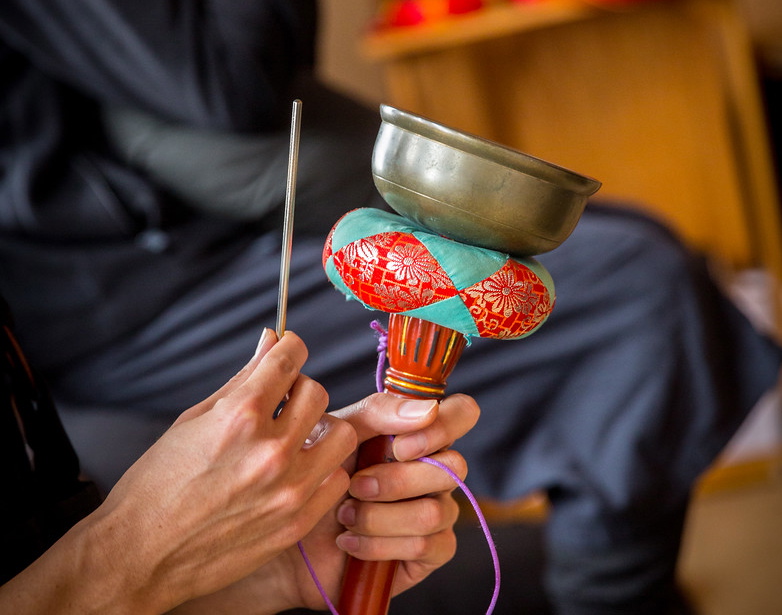
At the Hazy Moon, we use many Zen terms carried forward from ancient monastic practice. Here is a glossary of words and phrases that you may encounter when you practice in a Zendo. Explanations of other Zen ceremonies and activities are found on our Practice & Traditions page.
Buddha – Literally, “awake.” Also refers to Shakyamuni Buddha, our original teacher.
Chiden – Person responsible for the care of the altars and ceremonial items.
Daisan – Private interview with a Sensei, or teacher.
Dennan – Attendant who assists with altar setup and passes out Chant Books for services.
Densho – The large hanging bell tolled in services.
Dharma Talk – Talk given by a sensei or other Zen student on an aspect of practice.
Dharani – A short Buddhist chant, often untranslatable, which is recited during services to invoke a certain attitude of mind.
Doan – A position responsible for playing bells during services.
Dokusan – Private interview with a Roshi or Abbot.
Eightfold Path – The Fourth Noble Truth taught by the Buddha as the way to end suffering. The Eightfold Path consists of right view, thought, speech, action, livelihood, effort, mindfulness, and samadhi.
Four Noble Truths – One of the Buddha’s first teachings about life and the way of Buddhism, consisting of: 1) life is suffering, 2) suffering has a cause, 3) there is a way to end the cause of suffering; and 4) the way is to follow the Eightfold Path.
Gakki – A memorial service for masters in our lineage.
Gassho – The mudra or gesture of placing the two palms together.
Gatha – A verse of four or more lines. Different gathas are chanted during the day at Zen centers, for example before talks and during meals.
Hako – The incense box carried in and out by the Jiko during services.
Han – Hanging wooden block struck to announce the time for zazen.
Hara – The region in the lower abdomen that is the seat of awareness in zazen. It is located approximately two inches below the navel.
Inkin – Small handbell with metal striker.
Ino – One of the head positions in the Zendo, the Ino leads services.
Jikido – The timekeeper for the Zendo.
Jiko – The Jiko carries the hako in and out of the Zendo during services.
Jisha – The attendant of a teacher or officiant, the Jisha works with the teacher during interviews (dokusan, daisan, etc.) and also attends to the teacher’s personal needs.
Kentan – Checking rounds done before dawn zazen by the most senior teacher present.
Kinhin – Walking meditation done between periods of seated zazen.
Koan – A brief anecdote relaying an exchange between a teacher and a student culminating in an enlightenment experience. A teacher may assign a koan for a student to penetrate, or practice, during zazen.
Kyosaku – Literally, “waking stick.” A wooden stick used to encourage practitioners during zazen. At this center it is used only when requested by the practitioner.
Mokugyo – A wooden drum used to keep the beat during chanting. It is traditionally shaped like a fish, thus the name which means “fish.”
Mudra – Symbolic hand positions or gestures.
Oryoki – Literally, “that which contains just enough.” It refers to the nested eating bowls we use during formal meals in the Zendo.
Practice – The term may refer to one’s zazen (i.e., one’s “practice”) or in a broader sense to include all facets of one’s life as practice.
Precepts – Teachings regarding personal conduct, which are both ethical guidelines and aspects of reality itself. At both jukai and tokudo ceremonies, sixteen precepts are received.
Rakusu – The smallest of the Buddhist robes, the rakusu is made of five strips of cloth which are sewn together and suspended from the neck by a cloth halter. Received during the jukai ceremony, it is worn by priests and laypersons.
Roshi – Literally, “old teacher,” an honorific for a Zen master.
Ryoban – The positions on either side of the altar during services and ceremonies.
Samadhi – A non-dualistic state of being attributed to zazen. Nyogen Roshi defines samadhi as “nondistracted awareness.”
Samu – Communal work done at the Center. Samu is working zazen.
Seiza – A kneeling posture for zazen typically using a seiza bench or zafu to support one’s weight.
Sensei – Literally, “one who goes before on the path.” An authorized teacher.
Sesshin – An intensive meditation retreat lasting from two to ten days. Sesshin offers the opportunity for intensive practice.
Shashu – Mudra used when walking or standing in the Zendo (left hand in a fist, thumb tucked in, covered by the right hand; both placed against the solar plexus).
Shikantaza – Literally, “just sitting.” The purest form of seated meditation, a state of alert attention free of thought, directed to no object, and attached to no particular content.
Sogei – The person who rings the hand-bell (inkan) to lead the officiant in and out of the Zendo.
Sutra – A dialogue or sermon attributed to the Buddha.
Teisho – A talk given by a roshi, usually on a koan or other Zen text. Teisho is the spontaneous, living spirit of Zen rather than an intellectual discourse.
Tenzo – Head cook.
Three Treasures – Buddha, Dharma, Sangha: the manifestations of our true nature. The treasure of Buddha is the awakened mind; the treasure of Dharma is purity; the treasure of Sangha is harmony.
Zabuton – Flat, black mat placed under a zafu.
Zafu – Literally, “sitting cushion.” Round, black meditation cushion.
Zagu – Priest’s foldable bowing cloth.
Zazen – Literally, “sitting meditation.” The practice of Zen meditation.
Zazenkai – One-day retreat.
Zendo – Meditation hall.
Above: The jikido strikes the inkan at the conclusion of a Jukai ceremony.
